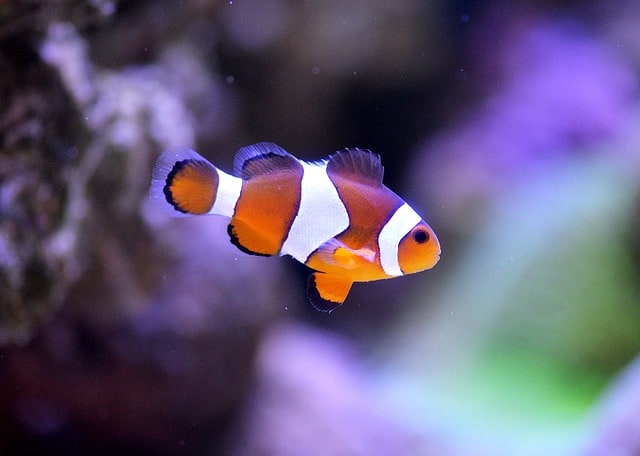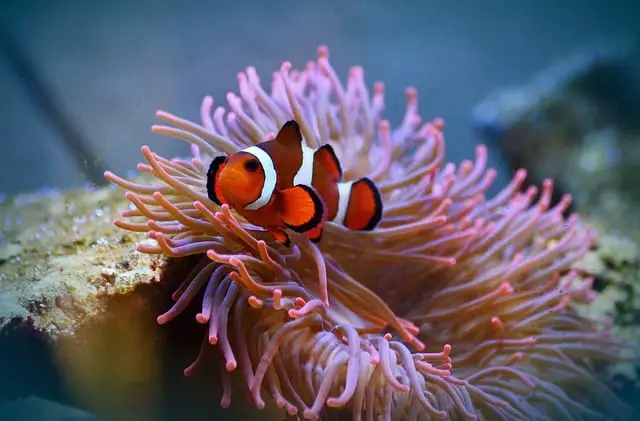‘Reef safe’ is a term used in the aquarium industry to indicate if a particular species of saltwater fish or invertebrate is okay to add to a marine tank with live rock or corals. Perhaps you’re new to the aquarist trade and want to start small. You may be asking yourself, ‘which fish are reef safe and suitable for a 30-gallon tank?’
Smaller or ‘dwarf’ species of saltwater angelfish, blennies, clownfish, cardinalfish, chromises, damselfish, dottybacks, gobies, and royal grammas can be kept in a 30-gallon reef tank. If you have a community tank, be sure the fish you choose are compatible since they’ll be sharing a limited space.
Now that you know the types of fish you can keep in a small reef tank, let’s explore this topic together in more detail. We’ll discover which species are best for a 30-gallon tank, how many fish you can keep at a time, and which ones make the best tankmates. We’ll also learn how to acclimate marine fish to a 30-gallon reef tank and how to set it up properly.
So, if you’re ready to learn more about stocking a 30-gallon reef tank, then let’s get to it!
What Saltwater Fish Can I Put in a 30 Gallon Reef Tank?
The ‘top 10’ saltwater fish for a 30-gallon reef tank include (but aren’t limited to):
Flame Angelfish
Flame angelfish are considered reef safe and adapt well to most captive marine environments. This fish is a dwarf species (reaches of lengths of no more than 4 inches) and therefore good for a 30-gallon tank. Flame angels are active, attractive, and beginner-friendly so they’re easy to feed and care for.

Tailspot Blennies
Tailspot blennies generally won’t grow any longer than 2 inches, making them the perfect addition to a 30-gallon reef tank. They’re a hardy species and can live for many years in captivity with proper care. Tailspots will spend most of their time hovering over corals and grazing on algae.
Percula Clownfish
Percula or ocellaris clownfish are both community tank and reef tank safe. They grow between 3 and 4 inches long and live up to 5 years in captivity. Often considered the most peaceful of their kind, percula clowns will do well in a 30-gallon tank with other fish of similar size and temperament like flame angels.
Banggai Cardinalfish
Banggai cardinalfish grow to about 3 inches in length and are great for a 30-gallon reef tank setup. They won’t pick at live rock or harm invertebrates living among the corals. This species is non-aggressive and gets along well with other peaceful marine fish like percula clownfish, for example.
Blue-Green Chromises
Blue-green chromis fish are reef safe and won’t harm corals or live rock. They’re a peaceful species and can be kept in marine tank with other fish of like size and temperament including tailspot blennies and percula clownfish. Reaching maximum length of 4 inches, they’ll do fine in a 30-gallon tank.
Blue Damselfish
Blue damselfish are smaller in size (about 3 inches long) and perfect for a 30-gallon reef tank. This species is not only attractive but hardy as well so it can adapt to most captive marine conditions with ease. Ideal tankmates include banggai cardinals, percula clowns, and tailspot blennies.
Neon Dottybacks
Neon dottybacks are reef safe and stay small (around 3 inches long). Despite their compact size, this species can get aggressive and therefore should be added last to a community tank. Keeping them with like-sized (clowns, damsels, etc.) or slightly larger (flame angels) fish is recommended.
Royal Grammas
Royal gramma fish will do well to almost any 30-gallon reef tank setup. They won’t pick corals and leave invertebrates alone. This species is both peaceful and easy to care for. Royal grammas reach lengths of up to 3 inches and make great tankmates for both blue-green chromises and fire gobies.
Fire Gobies
Firefish are peaceful and considered reef safe. This species stays small (2 to 3 inches when fully grown) and won’t harm corals or attack crustaceans dwelling among live rock. When kept in a 30-gallon tank, fire gobbies do well with same-sized fish including percula clowns and blue-green chromises.

Peppermint Shrimp
Peppermint shrimp are a type of saltwater invertebrate and perfect for a 30-gallon reef tank. This species will only eat dead or dying corals and poses no threat to healthy live rock. Hardy and easy to care for, peppermint shrimp are ornamental and stay small – reaching lengths of no more than 2 inches.
How Many Fish Can I Put in a 30 Gallon Reef Tank?
The general ‘rule of thumb’ for stocking a saltwater tank is 1 inch of fish per gallon of water. However, dependent on their behavior and temperament, you may need to amend this rule a bit. I’d suggest 1 inch of fish to every 2 gallons since having extra space is always better than being overcrowded.
Try to limit your options to smaller, peaceful, non-territorial fish (if possible) that grow to lengths of no more than a few inches. Up to 15 total inches of fish should be fine for a 30-gallon reef tank. Keep in mind that active fish need more space to forage and explore their aquatic surroundings.
Tools for Acclimating Marine Fish to a Reef Tank?
Acclimating marine fish to a reef tank usually takes between 30 to 60 minutes. You must be cautious and patient when introducing fish to a new aquatic environment. Assuming your tank is already established, simply follow the steps listed below:
- Float the bag with the new fish in the reef tank for at least half an hour – this allows time for the water in the bag to reach the same temperature as the water in the tank.
- After 30 minutes have passed, open the bag and test the salinity of the water to ensure it’s within .001 of the receiving tank.
- If the salinity is within range, gently release the fish into the tank – only add the fish – do not add the water from the bag to the tank.
- If the salinity isn’t within range, try an alternative method: place the fish and the bag water into a bucket and then slowly add a cup of tank water to the bucket every 5 minutes – do this until the water volume in the bucket has doubled and then discard half the water and repeat the process until the volume has doubled yet again.
- Once the water volume in the bucket has been doubled twice, carefully scoop the fish out of the bucket with an aquarium net and release into the reef tank.
Besides Fish, What Other Creatures Can be Kept in a 30 Gallon Reef Tank?
Contrary to popular belief, a reef tank can be home to more than just fish! Invertebrates like shrimp can also thrive in a saltwater tank with corals and live rock. The best options for a 30-gallon tank include smaller species like cleaner shrimp, banded coral shrimp, peppermint shrimp, and harlequin shrimp.
Crustaceans like crabs can also do well in a reef tank setup. For a 30-gallon size, consider smaller, peaceful species like hermit crabs, emerald crabs, and anemone crabs. Avoid hostile types like arrow crabs if you have a community tank with banded coral shrimp as they’ve been known to attack them!
Conclusion
To sum things up, ‘dwarf’ species of fish are best for a smaller aquarium. Regarding a 30-gallon reef tank, the best options include saltwater angels, blennies, clownfish, cardinalfish, chromises, damsels, dottybacks, gobies, and shrimp that stay under 4 inches long and won’t pick at corals. For a community tank setup, make sure the fish you choose are all compatible with one another.
I trust this article has provided you with the information you seek regarding which fish are considered reef safe for a 30-gallon marine tank. Thanks for reading and good luck with your saltwater aquarium!
Related Posts
Reef Safe Fish for a 55 Gallon Tank?
Can You Keep a Lionfish in a Reef Tank?
Best Inverts for a Nano Reef Tank
Will Hawkfish Eat Cleaner Shrimp?
Best Shrimp for a Reef Tank (Top 10 Picks)
How to Get Rid of Aiptasia in a Reef Tank?
Are Copperband Butterflyfish Reef Safe?




